
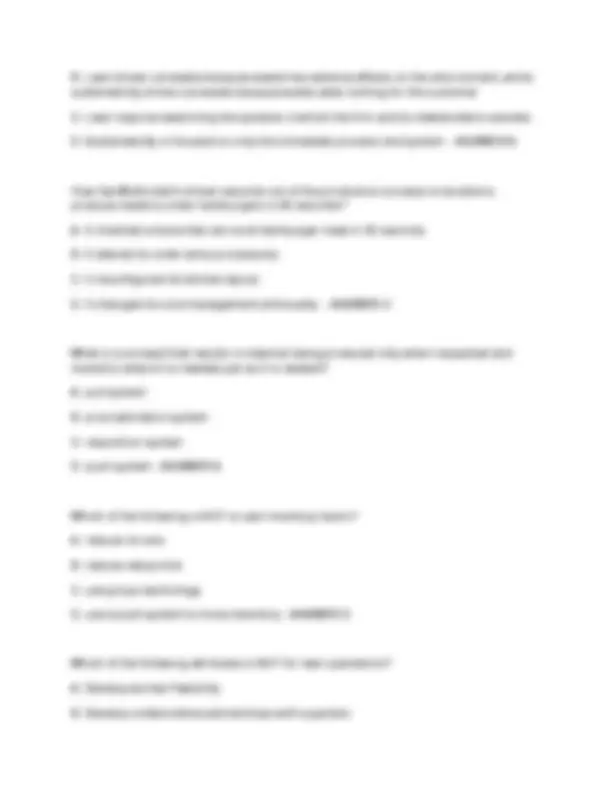
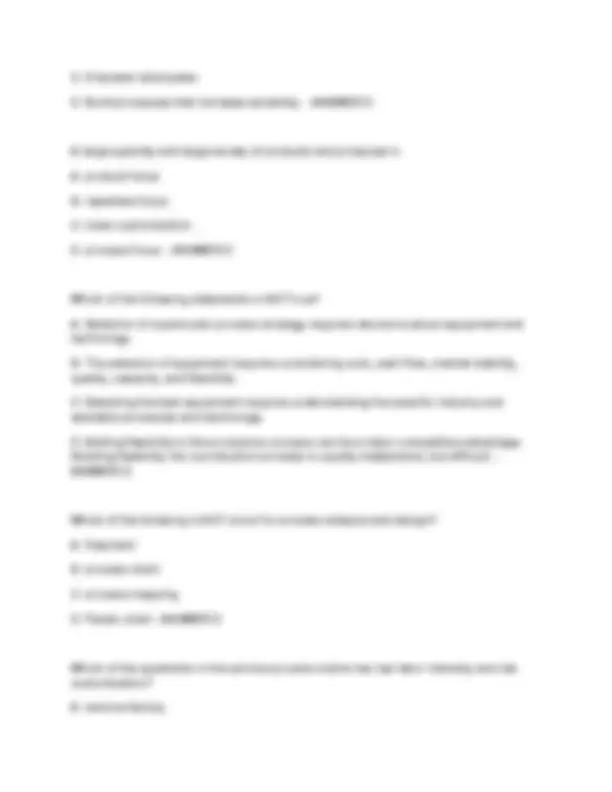
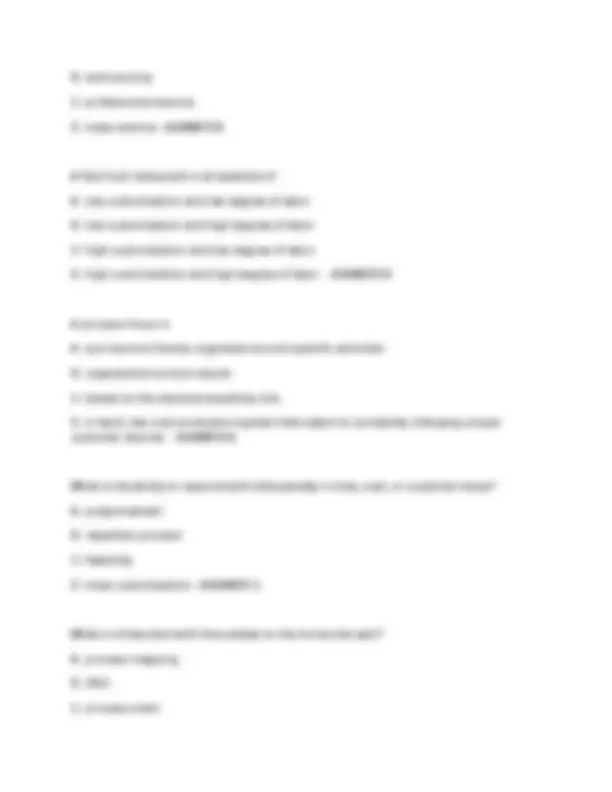
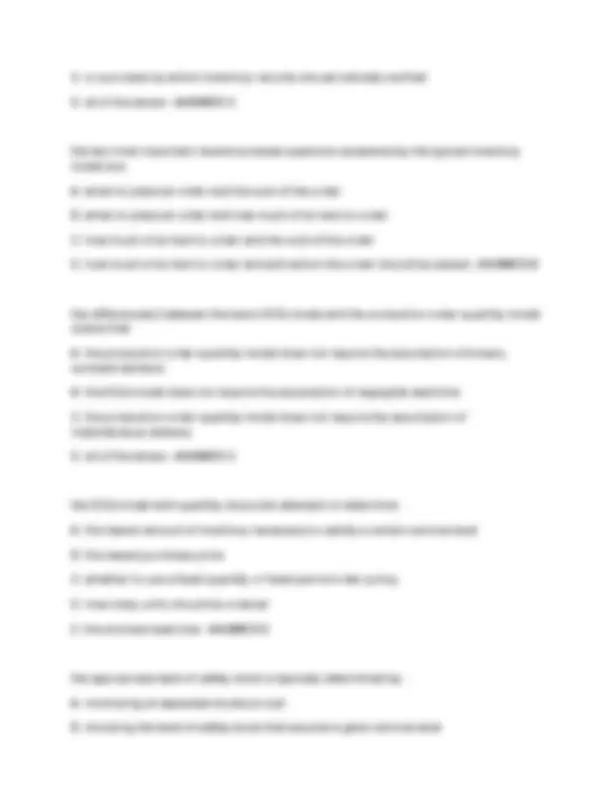
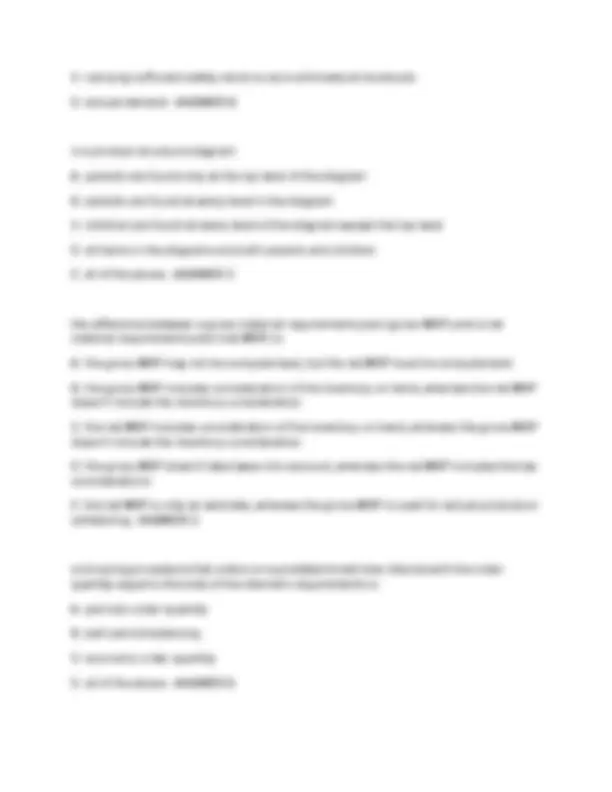
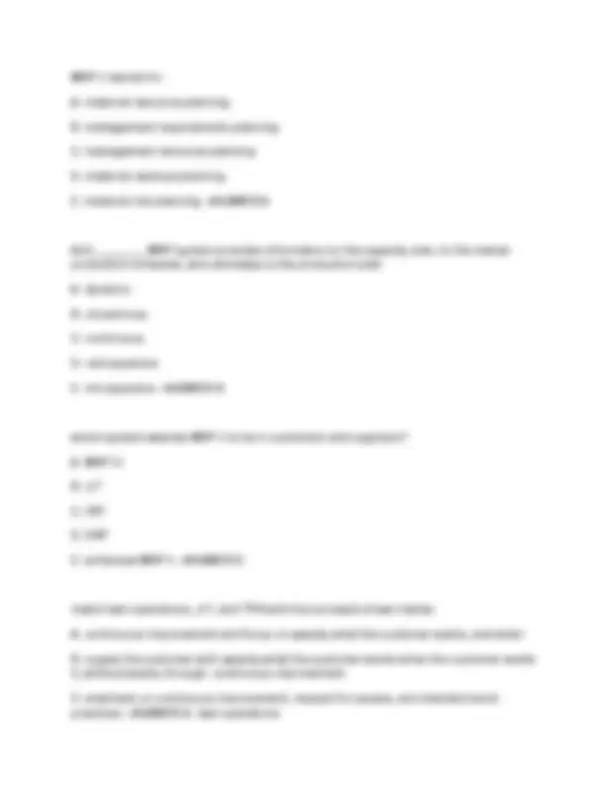
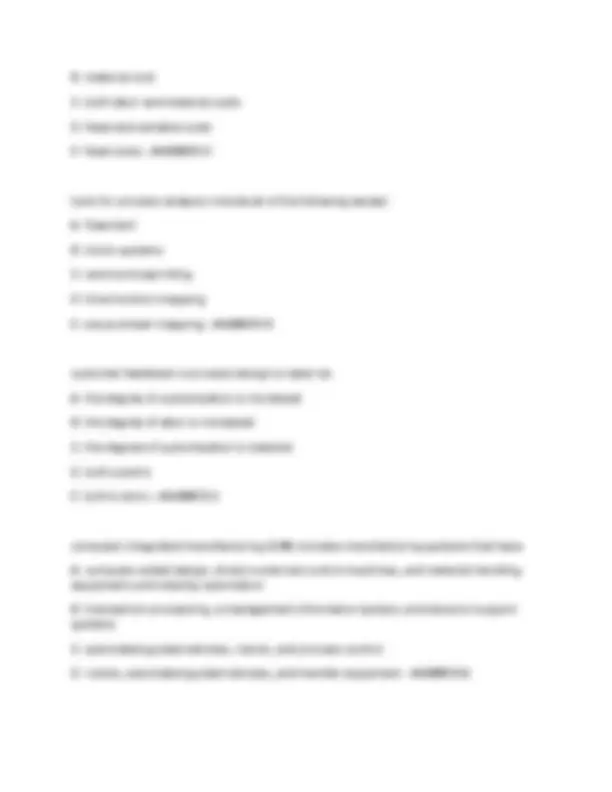


Study with the several resources on Docsity

Earn points by helping other students or get them with a premium plan


Prepare for your exams
Study with the several resources on Docsity

Earn points to download
Earn points by helping other students or get them with a premium plan
Community
Ask the community for help and clear up your study doubts
Discover the best universities in your country according to Docsity users
Free resources
Download our free guides on studying techniques, anxiety management strategies, and thesis advice from Docsity tutors
SCM 186 Final Exam Questions And 100% Correct Answers
Typology: Exams
1 / 13

This page cannot be seen from the preview
Don't miss anything!








What are the two most important cost considerations in queuing problems? A. cost of line management and cost of marketing B. cost of lost time waiting and cost of marketing C. cost of providing service and cost of marketing D. cost of providing service and cost of waiting time - ANSWER D
Which of the following is NOT one of the techniques that Disney uses to try to keep visitors happy while waiting in line? A. serves drinks B. makes lines appear to be constantly moving forward C. entertains people while they wait D. posts signs telling visitors how many minutes until they reach each ride - ANSWER A
Customers who ________ refuse to join the waiting line because it is too long to suit their needs or interests. A. queue B. Poisson C. renege D. balk - ANSWER D
Inventory control models assume that demand for an item is A. identical to the demand for other items. B. always dependent on the demand for other items. C. always independent on the demand for other items. D. either independent of or dependent on the demand for other items. - ANSWER D
Extra units that are held in inventory to reduce stockouts are called A. just-in-time inventory. B. demand variance. C. reorder point. D. safety stock. - ANSWER D
Which of the following is NOT one of the basic assumptions of the basic EOQ model? A. Receipt of inventory is instantaneous and complete. B. Lead time is known and consistent C. Demand for an item is known. D. Quantity discounts are possible. - ANSWER D
Inventory reduction via JIT is an effective tool for identifying A. holding costs. B. causes of variability. C. setup costs. D. inefficiencies in warehouse layout. - ANSWER B
Which of the following words means continuous improvement in Japanese? A. sensei B. kanban C. poka-yoke D. kaizen - ANSWER D
Which of the following statements is true regarding lean sustainability? A. Lean and sustainability both seek to maximize resource and economic efficiency.
C. Empower employees. D. Build processes that increase variability. - ANSWER D
A large quantity and large variety of products are produced in A. product focus. B. repetitive focus. C. mass customization. D. process focus. - ANSWER C
Which of the following statements is NOT true? A. Selection of a particular process strategy requires decisions about equipment and technology. B. The selection of equipment requires considering cost, cash flow, market stability, quality, capacity, and flexibility. C. Selecting the best equipment requires understanding the specific industry and available processes and technology. D. Adding flexibility to the production process can be a major competitive advantage. Building flexibility into a production process is usually inexpensive, but difficult. - ANSWER D
Which of the following is NOT a tool for process analysis and design? A. flowchart B. process chart C. process mapping D. Pareto chart - ANSWER D
Which of the quadrants in the service process matrix has low labor intensity and low customization? A. service factory
B. service shop C. professional service D. mass service - ANSWER A
A fast food restaurant is an example of A. low customization and low degree of labor. B. low customization and high degree of labor. C. high customization and low degree of labor. D. high customization and high degree of labor. - ANSWER A
A process focus is A. a production facility organized around specific activities. B. organized around products. C. based on the classical assembly line. D. a rapid, low-cost production system that caters to constantly changing unique customer desires. - ANSWER A
What is the ability to respond with little penalty in time, cost, or customer value? A. postponement B. repetitive process C. flexibility D. mass customization - ANSWER C
What is a flowchart with time added on the horizontal axis? A. process mapping B. CNC C. process chart
D. service times follow the exponential distribution E. servers each perform at their own individual speeds - ANSWER E
if everything else remains the same, including the mean arrival rate and service rate, except that the service time becomes constant instead of exponential: A. the average queue length will be halved B. the average waiting time will be doubled C. the average queue length will increase D. we cannot tell from the information provided - ANSWER A
a company has one computer technician who is responsible for repairs on the company's 20 computers. as a computer breaks, the technician is called to make the repair. if the repairperson is busy, the machine must wait to be repaired. this is an example of: A. a multiple-server system B. a finite population system C. a constant service rate system D. a. multiphase system E. all of the above - ANSWER B
ABC analysis divides on-hand inventory into 3 classes, based on: A. unit price B. the number of units on hand C. annual demand D. annual dollar values - ANSWER D
cycle counting: A. provides a measure of inventory turnover B. assumes that all inventory records must be verified with the same frequency
C. is a process by which inventory records are periodically verified D. all of the above - ANSWER C
the two most important inventory-based questions answered by the typical inventory model are: A. when to place an order and the cost of the order B. when to place an order and how much of an item to order C. how much of an item to order and the cost of the order D. how much of an item to order and with whom the order should be placed - ANSWER B
the difference(s) between the basic EOQ model and the production order quantity model is(are) that: A. the production order quantity model does not require the assumption of known, constant demand B. the EOQ model does not require the assumption of negligible lead time C. the production order quantity model does not require the assumption of instantaneous delivery D. all of the above - ANSWER C
the EOQ model with quantity discounts attempts to determine: A. the lowest amount of inventory necessary to satisfy a certain service level B. the lowest purchase price C. whether to use a fixed-quantity or fixed-period order policy D. how many units should be ordered E. the shortest lead time - ANSWER D
the appropriate level of safety stock is typically determined by: A. minimizing an expected stockout cost B. choosing the level of safety stock that assures a given service level
MRP II stands for: A. material resource planning B. management requirements planning C. management resource planning D. material revenue planning E. material risk planning - ANSWER A
A(n) _________ MRP system provides information to the capacity plan, to the master production schedule, and ultimately to the production plan A. dynamic B. closed-loop C. continuous D. retrospective E. introspective - ANSWER B
which system extends MRP II to tie in customers and suppliers? A. MRP III B. JIT C. IRP D. ERP E. enhanced MRP II - ANSWER D
match lean operations, JIT, and TPS with the concepts shown below: A. continuous improvement and focus on exactly what the customer wants, and when B. supply the customer with exactly what the customer wants when the customer wants it, without waste, through. continuous improvement C. emphasis on continuous improvement, respect for people, and standard work practices - ANSWER A. lean operations
the 7 wastes are: the 5 S's are: - ANSWER 1. overproduction
concerns of suppliers when moving to supplier partnerships include: A. small lots sometimes seeming economically prohibitive B. realistic quality demands C. changes without adequate lead time D. erratic schedules E. all of the above - ANSWER E
kanban is the Japanese word for: A. car
B. material cost C. both labor and material costs D. fixed and variable costs E. fixed costs - ANSWER D
tools for process analysis include all of the following except: A. flowchart B. vision systems C. service blueprinting D. time-function mapping E. value-stream mapping - ANSWER B
customer feedback in process design is lower as: A. the degree of customization is increased B. the degree of labor is increased C. the degree of customization is lowered D. both a and b E. both b and c - ANSWER C
computer-integrated manufacturing (CIM) includes manufacturing systems that have: A. computer-aided design, direct numerical control machines, and material-handling equipment controlled by automation B. transaction processing, a management information system, and decision support systems C. automated guided vehicles, robots, and process control D. robots, automated guided vehicles, and transfer equipment - ANSWER A